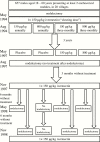Macrofilaricidal Efficacy of Repeated Doses of Ivermectin for the Treatment of River Blindness
- PMID: 29020189
- PMCID: PMC5850622
- DOI: 10.1093/cid/cix616
Macrofilaricidal Efficacy of Repeated Doses of Ivermectin for the Treatment of River Blindness
Abstract
Background: Mass drug administration (MDA) with ivermectin is the cornerstone of efforts to eliminate human onchocerciasis by 2020 or 2025. The feasibility of elimination crucially depends on the effects of multiple ivermectin doses on Onchocerca volvulus. A single ivermectin (standard) dose clears the skin-dwelling microfilarial progeny of adult worms (macrofilariae) and temporarily impedes the release of such progeny by female macrofilariae, but a macrofilaricidal effect has been deemed minimal. Multiple doses of ivermectin may cumulatively and permanently reduce the fertility and shorten the lifespan of adult females. However, rigorous quantification of these effects necessitates interrogating longitudinal data on macrofilariae with suitably powerful analytical techniques.
Methods: Using a novel mathematical modeling approach, we analyzed, at an individual participant level, longitudinal data on viability and fertility of female worms from the single most comprehensive multiple-dose clinical trial of ivermectin, comparing 3-monthly with annual treatments administered for 3 years in Cameroon.
Results: Multiple doses of ivermectin have a partial macrofilaricidal and a modest permanent sterilizing effect after 4 or more consecutive treatments, even at routine MDA doses (150 µg/kg) and frequencies (annual). The life expectancy of adult O. volvulus is reduced by approximately 50% and 70% after 3 years of annual or 3-monthly (quarterly) exposures to ivermectin.
Conclusions: Our quantification of macrofilaricidal and sterilizing effects of ivermectin should be incorporated into transmission models to inform onchocerciasis elimination efforts in Africa and residual foci in Latin America. It also provides a framework to assess macrofilaricidal candidate drugs currently under development.
Keywords: ivermectin; macrofilaricide; multiple dose; onchocerciasis; river blindness.
© The Author 2017. Published by Oxford University Press for the Infectious Diseases Society of America.
Figures




Similar articles
-
Effects of standard and high doses of ivermectin on adult worms of Onchocerca volvulus: a randomised controlled trial.Lancet. 2002 Jul 20;360(9328):203-10. doi: 10.1016/S0140-6736(02)09456-4. Lancet. 2002. PMID: 12133654 Clinical Trial.
-
Macrofilaricidal activity after doxycycline only treatment of Onchocerca volvulus in an area of Loa loa co-endemicity: a randomized controlled trial.PLoS Negl Trop Dis. 2010 Apr 13;4(4):e660. doi: 10.1371/journal.pntd.0000660. PLoS Negl Trop Dis. 2010. PMID: 20405054 Free PMC article. Clinical Trial.
-
Short report: impact of ivermectin community-level treatments on elimination of adult Onchocerca volvulus when individuals receive multiple treatments per year.Am J Trop Med Hyg. 2005 Dec;73(6):1159-61. Am J Trop Med Hyg. 2005. PMID: 16354830
-
River Blindness: Mathematical Models for Control and Elimination.Adv Parasitol. 2016;94:247-341. doi: 10.1016/bs.apar.2016.08.003. Epub 2016 Oct 7. Adv Parasitol. 2016. PMID: 27756456 Review.
-
Elimination of human onchocerciasis: history of progress and current feasibility using ivermectin (Mectizan(®)) monotherapy.Acta Trop. 2011 Sep;120 Suppl 1:S100-8. doi: 10.1016/j.actatropica.2010.08.009. Epub 2010 Aug 27. Acta Trop. 2011. PMID: 20801094 Review.
Cited by
-
High-content approaches to anthelmintic drug screening.Trends Parasitol. 2021 Sep;37(9):780-789. doi: 10.1016/j.pt.2021.05.004. Epub 2021 Jun 3. Trends Parasitol. 2021. PMID: 34092518 Free PMC article. Review.
-
Onchocerca volvulus-specific antibody and cellular responses in onchocerciasis patients treated annually with ivermectin for 30 years and exposed to parasite transmission in central Togo.PLoS Negl Trop Dis. 2022 May 3;16(5):e0010340. doi: 10.1371/journal.pntd.0010340. eCollection 2022 May. PLoS Negl Trop Dis. 2022. PMID: 35503786 Free PMC article.
-
Effects of an injectable long-acting formulation of ivermectin on Onchocerca ochengi in zebu cattle.Parasite. 2020;27:36. doi: 10.1051/parasite/2020036. Epub 2020 May 18. Parasite. 2020. PMID: 32420864 Free PMC article.
-
Impact of short-term discontinuation of ivermectin-based chemoprevention on onchocerciasis transmission in endemic settings with long history of mass drug administration.PLoS Negl Trop Dis. 2023 Apr 14;17(4):e0011250. doi: 10.1371/journal.pntd.0011250. eCollection 2023 Apr. PLoS Negl Trop Dis. 2023. PMID: 37058547 Free PMC article.
-
Can mass drug administration of moxidectin accelerate onchocerciasis elimination in Africa?Philos Trans R Soc Lond B Biol Sci. 2023 Oct 9;378(1887):20220277. doi: 10.1098/rstb.2022.0277. Epub 2023 Aug 21. Philos Trans R Soc Lond B Biol Sci. 2023. PMID: 37598705 Free PMC article.
References
-
- World Health Organization. Accelerating work to overcome the global impact of neglected tropical diseases: a roadmap for implementation. Geneva: World Health Organization, 2012. Available at: http://www.who.int/neglected_diseases/NTD_RoadMap_2012_Fullversion.pdf. Accessed 7 March 2017.
-
- Progress towards eliminating onchocerciasis in the WHO Region of the Americas: verification of elimination of transmission in Mexico. Wkly Epidemiol Rec, 2015; 90: 577–81. - PubMed
Publication types
MeSH terms
Substances
LinkOut - more resources
Full Text Sources
Other Literature Sources

